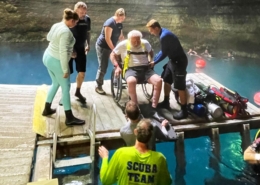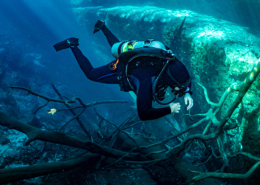When is it a good day to dive?
By Rick Peck
The standard answer is “It’s always a good day to dive.” The real question is; When is it a day we should not dive?
There are several factors that go into a decision for a dive day.
- Weather
- Waves
- Tides (if applicable)
- Physical condition
- Mental condition
- Water visibility
Weather
We would all like to dive in bright sunny conditions. Unfortunately, that doesn’t always happen. It is always a good idea to check the forecast before a dive day. The weather directly before a dive might be bright and sunny, but in some areas, thunderstorms roll in quickly. While it may be an interesting experience to see a lightning storm underwater with the strobe effect, we do have to come up sometime. A 30+ pound lightning rod strapped to your back makes for a very dangerous exit.
Wind is also a concern. Storms that roll in quickly can bring gust fronts that make for dangerous conditions. It could be flat and calm when you enter, and you may ascend after the dive into 5-6 foot chop with a dangerous exit onto the boat. Having a boat drop on your head or getting tangled in the ladder is not fun.
Waves and Tides
Shore diving in a coastal area makes waves a concern. Waves are generated by wind speed, duration and fetch. If there is a storm offshore you could be seeing big waves with very little wind in your area. Linked to the wave action is the tide. At some sites, waves tend to fizzle out at extreme high tide, making for easier entry and exits.
Tides can also affect your dive in an inlet. There is a popular dive site in my area that normally dives from a half-hour before high tide to a half-hour after high tide because of the current generated by the tidal change. The tidal currents can become so strong that an average diver can’t overcome them. The question is: does the tide change match the time you have available to dive? Your local dive shop should have recommendations on where and when is the best time to shore dive. As we learned in our Open Water class, local knowledge is the best.
Physical Condition
Are you healthy enough to dive? Do you have the physical conditioning to safely do the dive you are planning? Pushing your physical limits directly after a cold or allergy attack could lead to an ear injury or worse. If you have been sick, maybe you don’t have the energy reserves to rescue yourself or a buddy if required. The typical “Oh, I’ll be alright” could put not only you but your dive buddy at risk as well. Don’t let your ego write checks that your body can’t fulfill.
Mental Condition
You could compare diving to driving a car. We have all heard of distracted driving. If you are mentally upset or dealing with a great deal of stress, it might be prudent to evaluate whether it’s a good day to dive. Frustration and an urgency to get into the water to “relax” could mean you are skipping items on your buddy checks and self-checks. Unless you have the mental discipline to set these worries aside, it is probably better to dive another day.
Water Visibility
While there is a segment of the diving population that likes to “Muck Dive,” in general we prefer to see what is around us. One type of diving where visibility is important is drift diving. It is a two-fold problem, if you stay shallow enough to avoid obstructions, you can’t see anything. If you go deep enough to see the bottom, depending on the speed of the current, there is a possibility of being driven into a coral head or some other obstruction that you don’t see approaching. It is also much easier to become separated from your buddy. Remember to discuss and set a lost buddy protocol before the dive.
Summary
While it seems like all the stars and moon must align in order to safely dive, it’s really simple. Check the weather, check the tides (If applicable), do a self-assessment, and don’t be reluctant to cancel a dive if the conditions warrant it when you arrive at the dive site. A little planning and forethought will lead to a safe enjoyable dive. Always remember to dive within the limits of your training, conditioning, and skill set.










Leave a Reply
Want to join the discussion?Feel free to contribute!